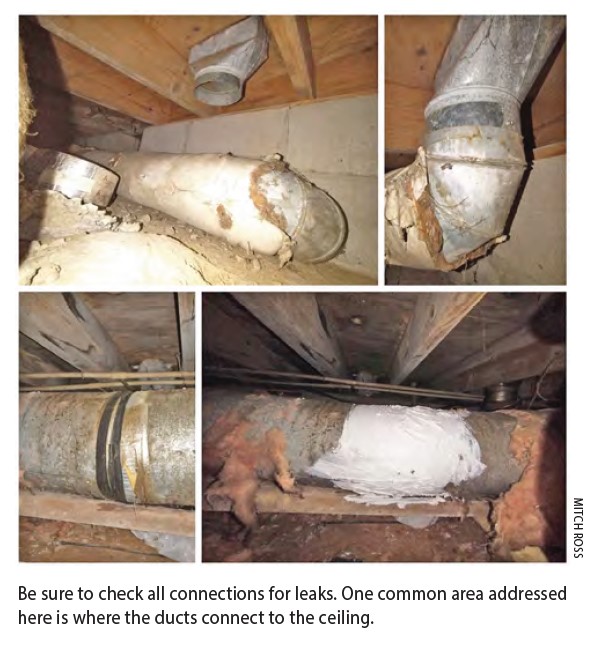Diagnosing duct leakage by Mitch Ross
 Imagine a ridiculous scenario with me. Let’s say your vehicle, which is rated to get 30 MPG, only gets about 20 MPG. Your fuel-efficient car is actually a gas guzzler! Apart from this reduced efficiency, you notice a gasoline smell each time you get in or out of your vehicle, and the concrete where you typically park is stained. Despite taking it to several mechanics, no one can diagnose the issue. In fact, they tell you the car seems to run just fine!
Imagine a ridiculous scenario with me. Let’s say your vehicle, which is rated to get 30 MPG, only gets about 20 MPG. Your fuel-efficient car is actually a gas guzzler! Apart from this reduced efficiency, you notice a gasoline smell each time you get in or out of your vehicle, and the concrete where you typically park is stained. Despite taking it to several mechanics, no one can diagnose the issue. In fact, they tell you the car seems to run just fine!
While the above scenario seems farfetched, I see and hear its equivalent all the time with regards to our homes! It wouldn’t take much training and just a little common sense to diagnose that there may be a leak somewhere in the fuel line. However, a problem that frequently goes undiagnosed with our homes is leaky ductwork. I especially like this analogy because leaky ductwork can have similar symptoms to a leaky fuel system. If your utility bills are higher than they should be, you smell musty or dusty air being pulled into the home from the attic or crawlspace, and you have uncomfortable rooms or zones in your home, these can all be indicators of a leaky duct system. There is a very good chance that you have leaky ducts, as the average home has around 30% duct leakage, meaning that for every dollar spent heating and cooling the average home, 30 cents’ worth never makes it inside!
I have been to many homes with these symptoms where homeowners were at a complete loss as to what the problem was. They had even had someone out to look at their HVAC system and were told that all was fine. But not to worry, there are a couple of ways you can determine for yourself if your home has this issue.
It can be an easy DIY inspection to check out your ductwork, though it may be unpleasant or uncomfortable, due to ductwork typically being in the attic or crawlspace. If DIY is not your thing, you can also have a home performance contractor or energyefficiency inspector check out your home for you, though it may be expensive to perform the duct blaster test used to quantify how leaky ducts are.
For a DIY inspection, set your thermostat fan setting to “On,” and go along your ducts listening and feeling for air escaping through the distribution system (the ducts that bring conditioned air into your home). Check the return duct, where you may not be able to feel air flowing, as it will be being sucked in rather blowing out. Look and listen for cracks and gaps or any disconnected or damaged ducts. If you find any leaky ducts, it’s usually an easy and worthwhile endeavor to fix them, but using the recommended materials is key. We aren’t talking about the gray ubiquitous “duck” tape, but rather mastic-backed HVAC tape and duct mastic putty, that comes in a small bucket. These items can usually be found at a local hardware store or HVAC supply house.
While there are some expensive options available, most homes would benefit greatly from a simple inspection and sealing with simple methods. Hopefully this will assist you with keeping your home efficient and comfortable, as well as making the air you breathe in your home healthier for your family.
Mitch Ross is the energy efficiency manager for the Electric Cooperatives of Arkansas.
